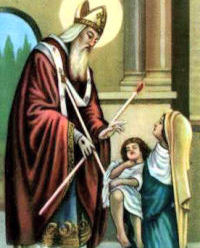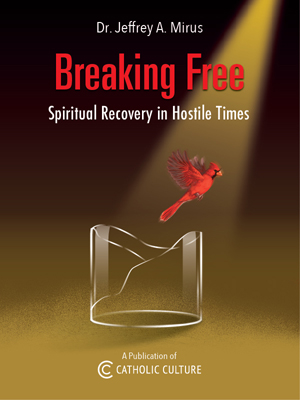Ordinary Time: February 3rd
Saturday of the Fourth Week in Ordinary Time; Optional Memorials of St. Blaise, Bishop and Martyr; St. Ansgar, Bishop
Other Titles: Blase
» Enjoy our Liturgical Seasons series of e-books!
The Universal Calendar offers two saints for celebration as Optional Memorials, Blaise and Ansgar. St. Blaise (or Blase) (d. 320) enjoyed widespread veneration in the Eastern and Western Churches due to many cures attributed to him. According to tradition, he was Bishop of Sebaste in Armenia and was martyred under Licinius. On this day the Church gives a "Blessing of the Throats" in honor of St. Blaise. From the eighth century he has been invoked on behalf of the sick, especially those afflicted with illnesses of the throat. St. Blaise is included in the list of Fourteen Holy Helpers.
St. Ansgar (801-865) became known as the "Apostle of the North" for his great evangelical work in Denmark and Sweden. He was Bishop of Hamburg, Germany and then of Bremen, Germany. Gregory IV appointed him as his delegate to Denmark and Sweden. Known for his great preaching, working miracles, and being greatly devoted to the poor and sick.
St. Blaise
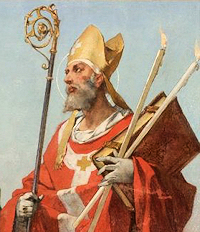 St. Blaise was a physician and Bishop of Sebaste, Armenia. He lived in a cave on Mount Argeus and was a healer of men and animals. According to legend, sick animals would come to him on their own for help, but would never disturb him at prayer.
St. Blaise was a physician and Bishop of Sebaste, Armenia. He lived in a cave on Mount Argeus and was a healer of men and animals. According to legend, sick animals would come to him on their own for help, but would never disturb him at prayer.
Agricola, governor of Cappadocia, came to Sebaste to persecute Christians. His huntsmen went into the forests of Argeus to find wild animals for the arena games, and found many waiting outside Blaise's cave. Discovered in prayer, Blaise was arrested, and Agricola tried to get him to recant his faith. While in prison, Blaise ministered to and healed fellow prisoners, including saving a child who was choking on a fish bone; this led to the blessing of throats on Blaise's feast day.
Thrown into a lake to drown, Blaise stood on the surface and invited his persecutors to walk out and prove the power of their gods; they drowned. When he returned to land, he was martyred by being beaten, his flesh torn with wool combs (which led to his association with and patronage of those involved in the wool trade), and then beheading.
Blaise has been extremely popular for centuries in both the Eastern and Western Churches and many cures were attributed to him, notably that of a child who was suffocating through a fish bone being caught in his throat. In 1222 the Council of Oxford prohibited servile labour in England on his feast. He is one of the Fourteen Holy Helpers. He is invoked for all throat afflictions, and on his feast two candles are blessed with a prayer that God will free from all such afflictions and every ill all those who receive this blessing.
—Excerpted from The Church's Year of Grace, Pius Parsch
Feast of St. Blaise—Invoking Against Diseases of the Throat
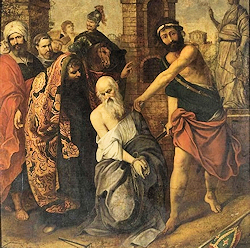 A physician of Sebaste in Cappodocia, where he was later named Bishop, St. Blaise was martyred about the year 320. He is venerated as a patron to protect us against diseases of the throat, mainly because of the story told that he cured a boy choking from a fishbone.
A physician of Sebaste in Cappodocia, where he was later named Bishop, St. Blaise was martyred about the year 320. He is venerated as a patron to protect us against diseases of the throat, mainly because of the story told that he cured a boy choking from a fishbone.
As a doctor Blaise went into every home, at all hours of the day and night, knew both the rich and poor of the neighborhood, comforted and cured and advised all. As a bishop, he did the same thing. It was said that people had to look for him in the prisons, in the caves with hermits, in the mountains and the valleys, so fast were his steps to search out and to help each member of his flock.
Blaise also had the reputation for curing sick and wounded animals, it was while he tended an animal that some of the governor's hunters found him and announced him as a Christian. This was their best catch, a bishop; and Blaise was ready, for he had been warned in prayer to prepare himself as a sacrifice. On his way to prison, Blaise greets his people along the ways, says goodbye to them, evangelizes them and baptizes. As he speaks, a voice is heard on the streets:
"Stop," says a woman, "my child is dying!"
"And what is the matter with this child?"
"There is a fishbone in his throat, and it is strangling him."
Is it a physician or a bishop that is needed? Blaise does not hesitate: medicine is too long, faith is shorter. He touches the elbow of the little boy, and commands the fishbone in the name of its maker:
"Go down or come out, by the law of the All-Powerful!"
The fishbone disappears and the child is returned safe and sound to his mother.
Blaise is thrown into prison, from which there is no exit except by adoration of the pagan gods. Upon his first refusal to worship, Blaise is whipped; and this achieves nothing, attempts are made to buy him off: he must keep his faith to himself, and simply appear at the official ceremonies of the state. Again he refuses, and is tortured, beaten and thrown into prison again.
"You punish my body," says Blaise, "but there is nothing you can do to my soul. If he wished, my God could snatch my body from your hands. His will be done."
"Do you think he could save you, if I had you drowned like cat in a pond?" asked the governor. Thereupon he orders Blaise to be thrown into a nearby lake, and is astonished to find the waters remain frozen like ice, unwilling to be an accomplice in the death of this holy man. In a frenzy, a soldier draws his sword, and with a single blow delivers Blaise from the hands of his tormentors into those of the living God.
—Excerpted from The Encyclopedia of Catholic Saints, Volume 2
Blessing of the Throats
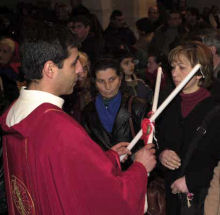 It is customary in many places to bless the throats of the faithful with two candles tied together with a red ribbon to form a cross. The rite of the blessing of throats may take place before or after Mass.
It is customary in many places to bless the throats of the faithful with two candles tied together with a red ribbon to form a cross. The rite of the blessing of throats may take place before or after Mass.
The priest or deacon places the candles around the throat of whoever seeks the blessing, using the formula: "Through the intercession of St. Blaise, bishop and martyr, may God deliver you free from every disease of the throat, and from every other disease. In the name of the Father and of the Son, + and of the Holy Spirit. R. Amen."
—Excerpted from Ceremonies of the Liturgical Year
Patronage: against angina; against bladder diseases; against blisters; against coughs; against dermatitis; against dropsy; against eczema; against edema; against fever; against goiters; against headaches; against impetigo; against respiratory diseases; against skin diseases; against snake bites; against sore throats; against stomach pain; against storms; against teething pain; against throat diseases; against toothaches; against ulcers; against whooping cough; against wild beasts; angina sufferers; animals; cattle; children; healthy throats; livestock; motorists; pack horses; pets; pigs; bakers; brick layers; builders; carvers; cobblers; construction workers; cowherds; farm workers; hat makers; hatters; millers; musicians who play wind instruments; plasterers; shoe makers; sock makers; stocking makers; stone cutters; stone masons; swineherds; tailors; tanners; veterinarians; wool-combers; wool weavers; Dalmatia; Paraguay
Symbols and Representation: iron wool comb representing the item used to torture him; hermit tending wild animals; candle; iron comb; man healing a choking boy; man with two candles; two candles; two crossed candles; wax
Highlights and Things to Do:
- Have your family attend Mass and receive the Blessing of Throats today.
- Establish a home altar with the blessed candles (symbols of Saint Blaise) from the feast of the Presentation, February 2.
- Read more about St. Blaise and how he saved Dubrovnik in Croatia in the 12th century.
- Read more about St. Blaise:
- See Catholic Cuisine for some food ideas for this saint.
- See August 8, for more details on the Fourteen Holy Helpers.
- St. Blaise's relics are claimed to be worldwide, in particular in Rome, Italy; Maratea, Italy; Dubrovnik, Croatia.
St. Ansgar
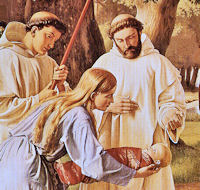 The "apostle of the north" (Scandinavia) had enough frustrations to become a saint—and he did. He became a Benedictine at Corbie, France, where he had been educated. Three years later, when the king of Denmark became a convert, Ansgar went to that country for three years of missionary work, without noticeable success. Sweden asked for Christian missionaries, and he went there, suffering capture by pirates and other hardships on the way. Less than two years later he was recalled, to become abbot of New Corbie (Corvey) and bishop of Hamburg. The pope made him legate for the Scandinavian missions. Funds for the northern apostolate stopped with Emperor Louis's death. After thirteen years' work in Hamburg, Ansgar saw it burned to the ground by invading Northmen; Sweden and Denmark returned to paganism.
The "apostle of the north" (Scandinavia) had enough frustrations to become a saint—and he did. He became a Benedictine at Corbie, France, where he had been educated. Three years later, when the king of Denmark became a convert, Ansgar went to that country for three years of missionary work, without noticeable success. Sweden asked for Christian missionaries, and he went there, suffering capture by pirates and other hardships on the way. Less than two years later he was recalled, to become abbot of New Corbie (Corvey) and bishop of Hamburg. The pope made him legate for the Scandinavian missions. Funds for the northern apostolate stopped with Emperor Louis's death. After thirteen years' work in Hamburg, Ansgar saw it burned to the ground by invading Northmen; Sweden and Denmark returned to paganism.
He directed new apostolic activities in the North, traveling to Denmark and being instrumental in the conversion of another king. By the strange device of casting lots, the king of Sweden allowed the Christian missionaries to return.
Ansgar's biographers remark that he was an extraordinary preacher, a humble and ascetical priest. He was devoted to the poor and the sick, imitating the Lord in washing their feet and waiting on them at table. He died peacefully at Bremen, Germany, without achieving his wish to be a martyr.
Sweden became pagan again after his death, and remained so until the coming of missionaries two centuries later.
—Excerpted from Saint of the Day, Leonard Foley, O.F.M.
Patronage: Denmark; Scandinavia; Sweden; city of Bremen, Germany; diocese of Bremen, Germany; diocese of Hamburg, Germany
Symbols and Representation: Wearing a fur pelise; holding the Catheral of Hamburg
Highlights and Things to Do:
- Read more about St. Ansgar:
- St. Ansgar's relics are located in Hamburg, Germany in two different churches: St. Mary's Cathedral (Domkirche St. Marien) and St. Ansgar's and St. Bernard's Church (St. Ansgar und St. Bernhard Kirche).


